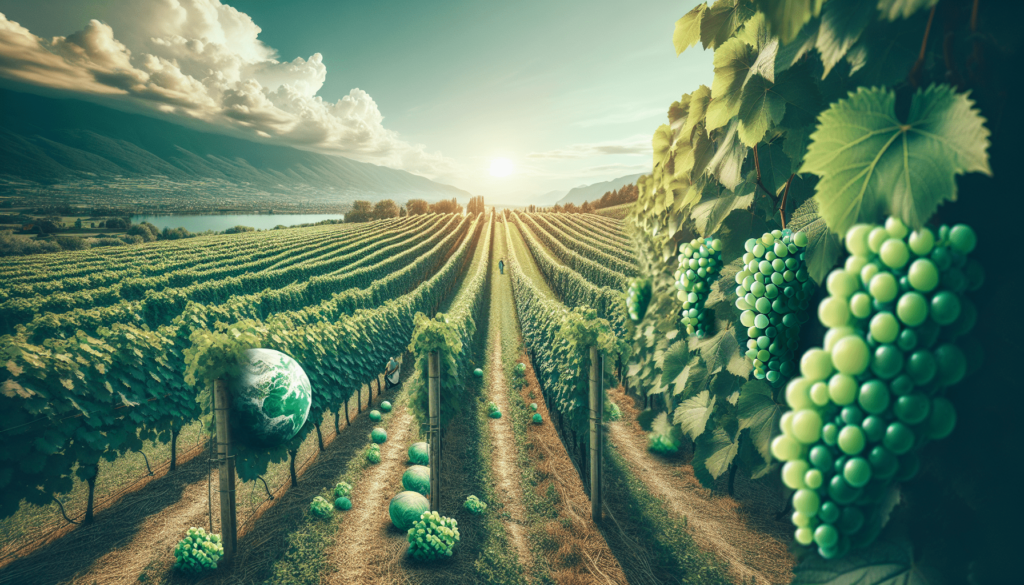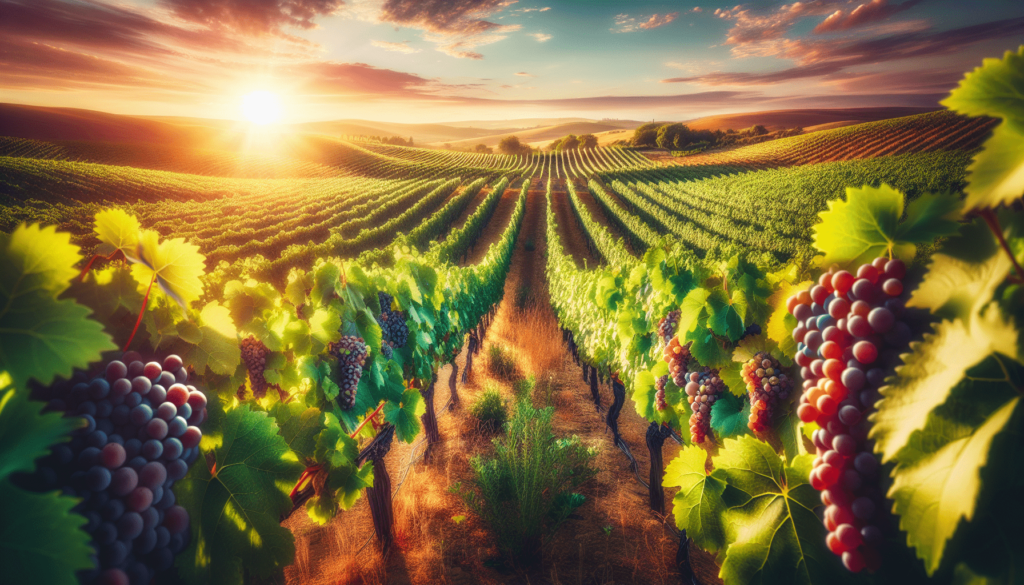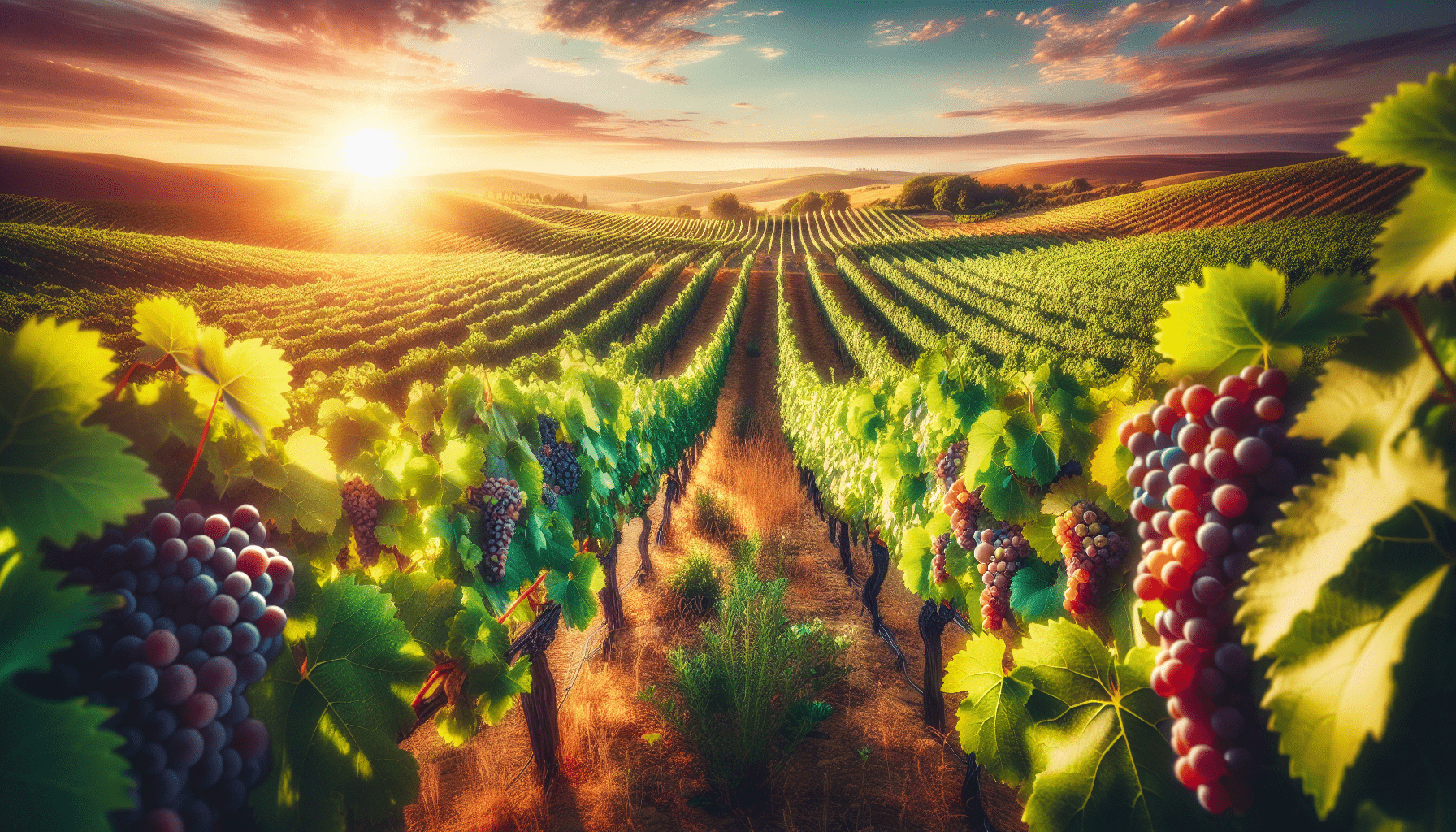Did you know that the wine industry is taking significant steps towards sustainability? From organic farming practices to water conservation efforts, winemakers around the world are recognizing the importance of minimizing their environmental impact. In this article, we will explore some of the key sustainable practices being implemented in the wine industry and how they are helping to preserve the planet while producing some of our favorite vintages. So grab a glass and join us on this journey into the world of sustainable winemaking!
1. Organic and Biodynamic Farming
1.1 Organic Farming Practices
Organic farming practices in the wine industry involve the use of natural methods and substances to cultivate grapevines and produce wine. These practices encourage biodiversity, the health of the soil, and the protection of natural habitats. Organic farmers avoid the use of synthetic fertilizers, pesticides, and herbicides, relying instead on techniques such as crop rotation, composting, and the use of natural predators to control pests.
1.2 Biodynamic Farming Practices
Biodynamic farming takes organic farming to the next level by incorporating a holistic and spiritual approach to agriculture. This method views the farm as a self-sustaining ecosystem and aims to achieve harmony between the crops, animals, and the natural environment. Biodynamic farmers follow a strict calendar that aligns planting, harvesting, and other agricultural activities with the moon and planetary cycles. They also prepare special composts and sprays derived from specific plant and animal materials to enhance soil fertility and vitality.
2. Water Conservation
2.1 Efficient Irrigation Systems
Water scarcity is a pressing issue in many wine regions. Efficient irrigation systems help conserve water by delivering the right amount of water to the vines, minimizing wastage. Drip irrigation systems, for example, directly deliver water to the root zone, reducing evaporation and runoff. Other systems, such as precision sprinklers, use weather data and soil moisture sensors to determine when and how much water to apply, optimizing water usage while maintaining vine health and grape quality.
2.2 Rainwater Harvesting
Rainwater harvesting is a valuable practice that utilizes natural rainfall to supplement irrigation needs. This approach involves capturing and storing rainwater runoff from roofs, vineyard slopes, and other surfaces. The collected rainwater can then be utilized during dry periods, reducing reliance on traditional water sources. By implementing rainwater harvesting systems, wineries can reduce their reliance on municipal water supplies, contributing to water conservation efforts.
2.3 Water Recycling and Treatment
Water recycling and treatment measures play a crucial role in conserving water and ensuring its sustainable use in winemaking practices. Many wineries have implemented wastewater treatment systems that treat and purify water used during production processes, allowing it to be reused for irrigation or other non-potable purposes. These systems remove contaminants and reduce the strain on freshwater resources, promoting a more sustainable water management approach in the wine industry.

3. Energy Efficiency
3.1 Use of Renewable Energy Sources
As the wine industry strives to reduce its environmental impact, the use of renewable energy sources has become increasingly prevalent. Wineries are harnessing the power of the sun by installing solar panels to generate electricity. This clean and renewable energy source helps offset their carbon footprint and reduces dependence on fossil fuels. In addition to solar energy, some wineries are exploring other sources such as wind and geothermal energy to further enhance their energy efficiency.
3.2 Energy-Efficient Lighting and Equipment
Another aspect of energy efficiency in the wine industry is the adoption of energy-saving lighting systems and equipment. LED lights, for example, are more efficient and have a longer lifespan compared to traditional lighting options. Wineries are also investing in energy-efficient winemaking equipment such as pumps, cooling systems, and barrel rooms that minimize energy consumption without compromising wine quality. These energy-saving measures not only reduce costs but also contribute to a more sustainable and eco-friendly wine production process.
3.3 Optimization of HVAC Systems
The heating, ventilation, and air conditioning (HVAC) systems in wineries consume significant amounts of energy. By optimizing these systems, wineries can reduce energy consumption and greenhouse gas emissions. This can be achieved through the installation of energy-efficient HVAC equipment, regular maintenance, and the use of advanced controls to regulate temperature and humidity levels. Additionally, some wineries are incorporating natural ventilation and passive cooling techniques into their facility designs to reduce the need for mechanical cooling systems.
4. Biodiversity Preservation
4.1 Conservation of Natural Habitats
Preserving natural habitats within and around vineyards is crucial for supporting biodiversity. Many wineries are committed to preserving existing woodlands, wetlands, and grasslands on their properties. These natural habitats provide essential ecosystems for native plants, insects, birds, and other wildlife species. By minimizing habitat destruction and implementing conservation measures, wineries can protect and enhance biodiversity in their vineyard landscapes, contributing to the overall health and resilience of the ecosystem.
4.2 Planting Cover Crops
Cover crops, such as legumes, grasses, and clovers, are strategically planted between vine rows to promote biodiversity and enhance soil health. These crops help prevent erosion, suppress weeds, and improve soil structure and fertility. They also attract beneficial insects and microorganisms that contribute to natural pest control and nutrient cycling. Wineries that incorporate cover crops into their vineyard management practices reap the benefits of increased biodiversity while reducing reliance on synthetic inputs.
4.3 Promotion of Wildlife Habitats
Creating wildlife habitats within vineyards is an effective way to support native species and foster ecological balance. Wineries can implement measures such as the installation of bird boxes, planting of native shrubs and trees, and the establishment of wildlife corridors. These efforts attract and support a diverse range of wildlife, including pollinators, predatory insects, birds, and mammals. By providing these habitats, wineries not only contribute to biodiversity preservation but also enhance the functionality and resilience of their vineyard ecosystems.

5. Soil Health Management
5.1 Composting and Mulching
Maintaining healthy soil is paramount for sustainable vineyard management. Composting and mulching play a vital role in enriching and protecting the soil. Wineries can compost organic waste materials such as grape pomace, organic grapevine prunings, and kitchen scraps to produce nutrient-rich compost. This compost can then be applied to the vineyard as a natural fertilizer, improving soil fertility and structure. Mulching, the practice of covering the soil with organic materials, also helps retain moisture, suppress weeds, and prevent erosion, further contributing to soil health.
5.2 Use of Natural Fertilizers
The use of natural fertilizers is an essential component of soil health management in sustainable vineyard practices. Rather than relying on synthetic fertilizers that can harm soil microorganisms and result in nutrient imbalances, wineries embrace natural alternatives such as compost, cover crops, and animal manure. These natural fertilizers provide a balanced array of nutrients while promoting the long-term health and fertility of the soil. By avoiding chemical inputs, wineries minimize their impact on the environment and produce wines that reflect the true characteristics of their terroir.
5.3 Soil Testing and Analysis
Regular soil testing and analysis are crucial in understanding the nutrient needs and overall health of the soil. Wineries can conduct comprehensive soil tests to monitor factors such as pH levels, nutrient content, and organic matter composition. Based on these results, they can adjust their fertilization practices and implement targeted soil amendments to optimize soil health and support grapevine growth. By ensuring the soil receives the right nutrients in the right quantities, wineries can produce healthy vines and high-quality grapes, all while minimizing environmental impact.
6. Pest and Disease Control
6.1 Integrated Pest Management
Integrated Pest Management (IPM) is a sustainable approach to pest and disease control that minimizes reliance on synthetic pesticides. Wineries employing IPM practices utilize a combination of preventive measures, cultural practices, and biological controls to manage pest and disease populations. These measures include monitoring pest populations, introducing beneficial insects and predators, implementing vineyard sanitation practices, and implementing sound vineyard management strategies. By prioritizing prevention and using targeted interventions only when necessary, wineries can effectively protect their crops while minimizing environmental harm.
6.2 Natural Predators and Beneficial Insects
Encouraging the presence of natural predators and beneficial insects in the vineyard is a key component of sustainable pest and disease control. Wineries can attract beneficial insects such as ladybugs, lacewings, and parasitic wasps by providing suitable habitats and companion plantings that offer nectar, pollen, and shelter. These beneficial insects act as natural predators, feeding on pest populations and helping to maintain a balanced ecosystem. By fostering the presence of these natural allies, wineries can reduce the need for chemical pesticides and promote long-term pest management without harming the environment.
6.3 Herbal and Botanical Remedies
In addition to biological controls, wineries can utilize herbal and botanical remedies to combat pest and disease issues in a sustainable manner. Certain plants possess natural pest-repellent properties that can be harnessed to deter or disrupt pest populations. For example, the planting of aromatic herbs such as mint or lavender can help repel pests, while the use of plant extracts such as neem oil or garlic can act as natural insecticides or fungicides. These plant-based remedies offer effective alternatives to synthetic chemicals, minimizing the impact on the environment while maintaining crop health and quality.
7. Waste Management
7.1 Recycling and Composting
Waste management practices in the wine industry focus on reducing, reusing, and recycling materials to minimize environmental impact. Wineries can implement comprehensive recycling programs that ensure various waste streams such as glass, paper, plastic, and metal are appropriately sorted and recycled. Additionally, organic waste materials such as grape pomace and grapevine prunings can be composted, turning them into valuable soil amendments. By diverting waste from landfills and embracing recycling and composting, wineries contribute to a circular economy and reduce their overall waste footprint.
7.2 Minimization of Packaging Waste
Packaging waste is a significant concern in the wine industry, with bottles, closures, and labels contributing to the overall waste stream. Wineries can adopt strategies to minimize packaging waste, such as using lightweight bottle designs, choosing eco-friendly closure options, and utilizing recycled or recyclable label materials. Some wineries even explore alternative packaging formats such as bag-in-box or cans, which offer reduced material usage and lower carbon footprint compared to traditional glass bottles. By prioritizing sustainable packaging solutions, wineries can contribute to waste reduction efforts and promote a more environmentally friendly wine sector.
7.3 Proper Disposal of Hazardous Materials
Proper disposal of hazardous materials is essential to prevent environmental contamination. Wineries must handle and dispose of chemicals, residues, and other potentially harmful materials in accordance with relevant regulations and best practices. This includes safely managing and disposing of pesticides, fertilizers, cleaning agents, and by-products of production processes. By adhering to strict guidelines and promoting responsible waste management, wineries can safeguard both the environment and the health of their workers and surrounding communities.
8. Carbon Footprint Reduction
8.1 Carbon Offsetting Programs
Reducing carbon emissions is a key objective in the wine industry’s sustainability efforts. Wineries can participate in carbon offsetting programs by investing in projects that reduce greenhouse gas emissions or sequester carbon. These projects can include initiatives like reforestation, renewable energy installations, or energy efficiency upgrades in other sectors. By offsetting their own emissions through these projects, wineries can achieve carbon neutrality and contribute to the global fight against climate change.
8.2 Use of Lightweight Packaging
The use of lightweight packaging materials is an effective strategy for reducing the carbon footprint of the wine industry. Choosing lighter bottles and packaging materials can significantly reduce transportation-related emissions, as less energy is required to transport lighter loads. Additionally, lightweight packaging options such as bag-in-box or cans have a lower carbon footprint compared to traditional glass bottles. By embracing lightweight packaging solutions, wineries can reduce their environmental impact and contribute to a more sustainable wine sector.
8.3 Transportation Efficiency
Efficient transportation practices play a crucial role in reducing the carbon footprint of the wine industry. Wineries can optimize logistics and distribution by implementing strategies such as route planning, load optimization, and the use of alternative transportation modes. This includes exploring options like rail or sea transport for long-distance shipments, which generally have lower emissions compared to road transport. By prioritizing transportation efficiency, wineries can minimize their carbon emissions associated with product distribution and contribute to a more sustainable supply chain.
9. Social Responsibility
9.1 Fair Trade Practices
Social responsibility in the wine industry involves ensuring fair and ethical treatment of workers throughout the supply chain. Wineries can engage in fair trade practices by partnering with certified organizations and ensuring fair wages, safe working conditions, and access to social benefits for their employees. Additionally, supporting fair trade certified products and cooperatives helps promote sustainable development and social justice in wine-growing regions. By embracing fair trade practices, wineries demonstrate their commitment to ethical business practices and contribute to positive social change.
9.2 Support for Local Communities
Wineries have the opportunity to make a positive impact on their local communities by supporting local initiatives and organizations. This can include partnerships with local farmers, suppliers, and service providers, which helps stimulate the local economy. Wineries can also offer educational programs, tours, and events that engage and involve the community, fostering a sense of place and connection to the land. By actively supporting and investing in their local communities, wineries can contribute to the social well-being and cultural richness of the regions they operate in.
9.3 Ethical Labor Practices
Ethical labor practices are essential for ensuring the well-being and dignity of workers in the wine industry. Wineries can prioritize the fair treatment of their employees by providing safe working conditions, training opportunities, and fair remuneration. This includes adhering to labor laws, fostering a positive work environment, and promoting diversity and inclusion. By embracing ethical labor practices, wineries not only uphold the rights of their workers but also promote a culture of respect and equality within the industry.
10. Certification and Standards
10.1 Organic and Biodynamic Certifications
Certification programs provide a means of verifying and recognizing wineries’ commitment to sustainable practices. Organic and biodynamic certifications are widely recognized in the wine industry and indicate adherence to specific standards and practices. Organic certification ensures that grapes are grown without the use of synthetic chemicals and follow strict organic farming practices. Biodynamic certification goes further, incorporating holistic and spiritual principles and practices that promote the health of the farm ecosystem. By achieving these certifications, wineries communicate their dedication to sustainable agriculture and provide assurance to consumers.
10.2 Sustainable Winegrowing Programs
Sustainable winegrowing programs offer comprehensive guidelines and frameworks that encompass all aspects of sustainability in the wine industry. These programs often involve third-party certification or self-assessment, providing wineries with a roadmap for implementing and improving sustainable practices. Programs such as the Sustainable Winegrowing Certification offer a holistic approach, addressing areas such as water and energy conservation, biodiversity preservation, and social responsibility. By participating in sustainable winegrowing programs, wineries demonstrate their commitment to continuous improvement and their responsibility as stewards of their environment.
10.3 Code of Conduct and Sustainability Guidelines
Beyond certification programs, wineries can develop and adopt their own code of conduct and sustainability guidelines. These internal frameworks outline the values and practices that the winery is committed to upholding, providing a clear direction for sustainable management. By creating their own guidelines, wineries can tailor their sustainability efforts to their specific circumstances and enhance their accountability. These frameworks also provide a basis for ongoing evaluation and improvement, ensuring that the winery remains aligned with its sustainability goals and continuously evolves to meet emerging challenges.
In conclusion, sustainable practices in the wine industry encompass a wide range of strategies and initiatives that prioritize environmental stewardship, social responsibility, and economic viability. From organic and biodynamic farming methods to water conservation, energy efficiency, and waste management, wineries are embracing sustainability across all aspects of their operations. By implementing these practices, wineries not only reduce their environmental and social impact but also produce high-quality wines that reflect the unique terroir of their vineyards. Furthermore, adherence to certifications, sustainable winegrowing programs, and the development of internal guidelines demonstrate wineries’ ongoing commitment to sustainability and their contribution to a more sustainable and resilient wine industry as a whole.

